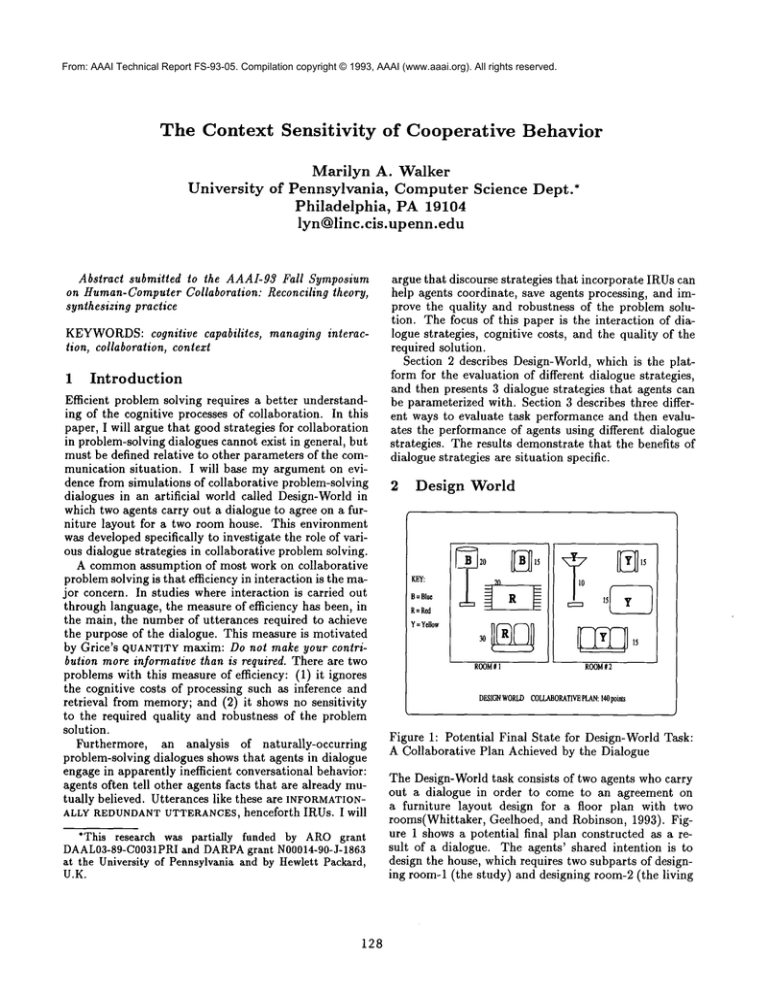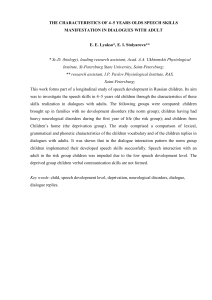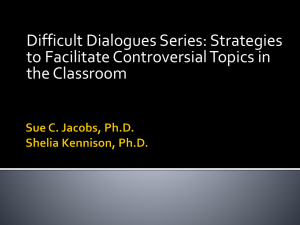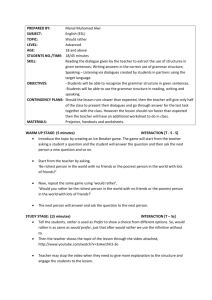
From: AAAI Technical Report FS-93-05. Compilation copyright © 1993, AAAI (www.aaai.org). All rights reserved.
The Context Sensitivity
University
of Cooperative Behavior
Marilyn
A. Walker
of Pennsylvania,
Computer
Philadelphia,
PA 19104
lyn@llnc.cis.upenn.edu
Abstract submitted to the AAAI-93 Fall Symposium
on Human-Computer
Collaboration: Reconciling theory,
synthesizing practice
KEYWORDS:
cognitive capabilites,
tion, collaboration, context
1
managing interac-
Introduction
Efficient problem solving requires a better understanding of the cognitive processes of collaboration. In this
paper, I will argue that good strategies for collaboration
in problem-solving dialogues cannot exist in general, but
must be defined relative to other parameters of the communication situation. I will base my argument on evidence from simulations of collaborative problem-solving
dialogues in an artificial
world called Design-Worldin
which two agents carry out a dialogue to agree on a furniture layout for a two room house. This environment
was developedspecifically to investigate the role of various dialogue strategies in collaborative problem solving.
A commonassumption of most work on collaborative
problemsolving is that efficiency in interaction is the major concern. In studies where interaction is carried out
through language, the measure of efficiency has been, in
the main, the number of utterances required to achieve
the purpose of the dialogue. This measure is motivated
by Grice’s QUANTITY
maxim: Do not make your contribution more informative than is required. There are two
problems with this measure of efficiency: (1) it ignores
the cognitive costs of processing such as inference and
retrieval from memory;and (2) it shows no sensitivity
to the required quality and robustness of the problem
solution.
Furthermore, an analysis of naturally-occurring
problem-solving dialogues shows that agents in dialogue
engage in apparently inefficient conversational behavior:
agents often tell other agents facts that are already mutually believed. Utterances like these are INFORMATIONALLYREDUNDANT
UTTERANCES, henceforth IRUs. I will
*This research was partially funded by AROgrant
DAAL03-89-C0031PRI
and DARPAgrant N00014-90-J-1863
at the University of Pennsylvania and by Hewlett Packard,
U.K.
128
Science
Dept.*
argue that discourse strategies that incorporate IRUscan
help agents coordinate, save agents processing, and improve the quality and robustness of the problem solution. The focus of this paper is the interaction of dialogue strategies, cognitive costs, and the quality of the
required solution.
Section 2 describes Design-World, which is the platform for the evaluation of different dialogue strategies,
and then presents 3 dialogue strategies that agents can
be parameterized with. Section 3 describes three different ways to evaluate task performance and then evaluates the performance of agents using different dialogue
strategies. The results demonstrate that the benefits of
dialogue strategies are situation specific.
2
Design
World
KEY:
B=Blue
R=Red
Y=Yellow
ROOM
#1
ROOM
#2
DK$1GNWORLD
COLLABORAT1VEPLAN:
140poi~s
Figure 1: Potential Final State for Design-World Task:
A Collaborative Plan Achieved by the Dialogue
The Design-World task consists of two agents who carry
out a dialogue in order to come to an agreement on
a furniture layout design for a floor plan with two
rooms(Whittaker, Geelhoed, and Robinson, 1993). Figure 1 shows a potential final plan constructed as a result of a dialogue. The agents’ shared intention is to
design the house, which requires two subparts of designing room-1 (the study) and designing room-2 (the living
room). A design for a room consists of any four pieces
of furniture of any of type, e.g. couch, table, chair, lamp
and rug. Each furniture item has a color and point value.
Each agent starts with private beliefs as to what pieces
of furniture s/he has and what colors these pieces are.
Agents share beliefs about which pieces of furniture exist
and how many points they are worth.
Through the dialogue, agents must reach an agreement about each piece in the proposed design. A sample
dialogue is given in 1: each utterance is shownboth as
a gloss in italics, and in the artificial language that the
agents communicate with.
(1) BILL: Then, let’s put the green rug in the study.
l:(propose agent-bill agent-kim option-l143: put-act
(agent-bill green rug room-l))
KIM:Then, let’s put the green lamp in the study.
2:(propose agent-kim agent-bill option-ll61: put-act
(agent-kim green lamp room-l)
BILL: No, instead let’s put the green couch in the
study.
3:(reject agent-bill agent-kim option-ll75: put-act
(agent-bill green couch room-l)
In 1, Bill makes a proposal in 1, and then Kimimplicitly accepts this proposal by making a new proposal. Variations on how agents communicate are discussed in section 2.2. The result of a dialogue is a
COLLABORATIVE-PLAN for how to design the house. The
following section will discuss the basis by which agents
make and accept proposals and carry out a dialogue to
agree on this plan.
2.1
Design-World
Communication
1. MSA&B(Intend A V B (oq A... a,,))
2. Voq (MS A&B(Contribute c~i (Achieve A&BGoal))
(al A...an) (Achieve
3. MS A&B(Max-Utility
Goal))
The predicate MSused in the definition of a collaborative plan means MUTUALLY
SUPPOSED, a type of defeasible mutual belief described in (Walker, 1992; Walker,
1993). For variations on the notion of a COLLABORAWIVEPLANsee (Walker and Whittaker, 1990; Cohen and
Levesque, 1991; Grosz and Sidner, 1990; Sidner, 1992)).
The next section describes the different dialogue strategies that agents can use to construct a collaborative plan.
KEY:
SpeakerChange
....... PossiblyNOSpeaker
Change
PROPOSE
’. _ ) Maybe IMPLICIT
~. _ACCEPT.7~’< I f
PROPOSE
’".., ,.....,.. SAY
I,
The means-end reasoner is a domainspecific reasoner developed specifically for Design-World. In Design-World,
unlike TileWorld, an option that is generated via meansend reasoning or from proposals of other agents only becomes an intention if it is ACCEPTED by both agents.
Thus each agent follows a schema for dialogue communication as shownin figure 2.1
By following the dialogue schema shown in figure
2 agents can construct
a COLLABORATIVE
PLAN. A
COLLABORATIVE-PLAN
for DESIGN-HOUSE
is achieved by
a cycle in which: (1) individual agents MEANS-ENDREASON about options in the domain; (2) individual agents
DELIBERATE
about which options are preferable; (3)
then agents make PROPOSALS
to other agents, based on
the options identified in a reasoning cycle, about actions
that contribute to the satisfaction of their intentions;
(4) then these proposals are ACCEPTED
or REJECTED
the other agent, or acceptance/rejection is postponed by
ASKING
for more information. Steps (1) and (2) of
process are solipsistic reasoning, while steps (3) and (4)
involve communication.
The dialogues that result are MIXED-INITIATIVE
because both agents reason about the domain and both
agents have goals so either agent can make a PROPOSAL
(Walker and Whittaker, 1990). Each agent deliberates
whether to accept or reject a proposal based on beliefs
about the proposed action’s utility and thus there is no
enforced collaboration (Axelrod, 1984; Bratman, Israel,
and Pollack, 1988; Doyle, 1992). The utility of a proposal is simply the points of the furniture item in the
proposal. Thus decisions about what to accept or reject
is based on agents’ goals to maximizethe score achieved
together by their design, and this is reflected in the definition of a COLLABORATIVE
PLAN(Walker,1993):
COLLABORATIVE-PLANA&B (Achieve
A&B Goal)
CLOSE, I
Figure 2: Dialogue Actions for the Design-World Task
The agent architecture for deliberation and means-end
reasoning is based on the IRMAarchitecture, also used
in the TileWorld simulation environment (Bratman, Israel, and Pollack, 1988; Pollack and Ringuette, 1990).
129
Design World Dialogue
Strategies
2.2
As figure 2 shows, some dialogue actions are optional.
For example, acceptance of a proposal can be conveyed
implicitly or explicitly. Dialogue openings and closings
can also be done implicitly. This variation in explicitness
1 These dialogue actions
are a simplification
of real
human-
humanproblem-solving dialogues. See (Carletta, 1992; Sidher, 1992) for alternate utterance taxonomies.
or implicitness is one basis for defining different dialogue
strategies. Furthermore, the information included in an
OPEN, PROPOSE, ACCEPT
and CLOSEcan be varied as a
discourse strategy parameter.
This paper compares the effectiveness of three different communicative strategies: (1) All-Implicit; (2)
Attitude-Explicit;
and (3) Warrant-Explicit. The AllImplicit strategy is exemplified by both agents Bill and
Kimin the dialogue in 1. Note that acceptance is never
communicatedexplicitly here; agents infer that another
agent accepted their proposal from the fact that nothing was said to indicate rejection. In addition, opening
and closing statements are left implicit, and no IRUs
that might function to reduce inference or retrieval are
included.
In 2, Agent EII uses the Attitude-Explicit strategy.
EII indicates acceptance of a proposal explicitly with
an IRU which consists of repeating the proposal. This
strategy is based on the commonuse of IRUs in natural
dialogues for this purpose. Agent KIMis an All-Implicit
agent.
(2) KIM:Then, let’s put the purple couch in the study.
4:(propose agent-kim agent-eft option-1078: put-act
(agent-kim purple couch room-l))
EII: OKAY, LET’S PUT THE PURPLE COUCH IN THE
2.3
Limited
Attention
Since a hypothesis about the role of IRUs is that they
help resource-bounded agents in processing, DesignWorld allows the experimenter to parameterize and keep
track of an agents’ processing capabilities, and explore
howthis interacts with the agents’ discourse strategies.
The parameter discussed here is the effect of limited Attention/Working Memory(AWM).Every simulation run
reported here varies this parameter, the basis for this
variation will be discussed below. Other cognitive parameters such as number of inferences and number of
retrievals from memoryare kept track of but not parameterized.
The AWM
model used in Design World is a very simple model that incorporates both recency and frequency
effects, and which has been shownto account for a broad
range of empirical results on human memoryand learning(Landauer, 1975). This model consists of a three dimensional space in which beliefs are stored in chronological sequence according to the current location of a moving memorypointer. Sequential memoryloci consist of
a random walk through the three dimensional memory
space. The effect of this storage mechanismis that beliefs acquired near the same time will be closer together
(recency), and beliefs stored in multiple locations have
a greater chance of being retrieved (frequency).
STUDY
5:(accept agent-eli agent-kim intended-1078: put-act
(agent-kim purple couch room-l))
bill-kim
The Warrant-Explicit strategy varies the way that
proposals are made by including IRUs in each proposal.
In general a WARRANT
for an intention is a reason for
adopting the intention. In Design-World WARRANT
IRUs
are the score propositions that give the utility of the
proposal. 2 Since these warrants are used by the other
agent in deliberation, the Warrant-Explicit strategy can
save the other agent from determining which facts are
relevant and retrieving them from memory. In the excerpt in 3 Warrant IRUs are shown in CAPS.
(3) IEI: PUTTING IN THE GREEN RUG IS WORTH 56
l:(say agent-iei agent-iei2 bel-265: score (option-202:
put-act (agent-bill green rug room-l) 56))
IEI: Then, let’s put the green rug in the study.
2:(propose agent-iei agent-iei2 option-202: put-act
(agent-bill green rug room-l))
These dialogue strategies interact with agents’ cognitive limitations. The cognitive limitation that is explored here is a limitation on Attention/Working Memory, henceforth AWM.The model of limited AWMis
briefly discussed in section 2.3. Then section 3 will
discuss the interaction of limited AWM
with dialogue
strategies and with the definition of the task.
2Rememberthat at the outset of the dialogues, agents
share beliefs about which pieces of furniture exist and how
manypoints they are worth.
130
AltecDtloNWorklng
Memory
Figure 3: Dialogues between TwoAll-Implicit
Averages of 100 runs
Agents,
For retrieval, search starts from the current memory
pointer location and spreads out in a spherical fashion.
Limits on AWM
are modeled by varying the the radius
of this search sphere as a Design-World parameter.
The plot in figure 3 demonstrates that AWM
models
the desired relationship between limits on Attention and
performance on the Design-World task. The point values associated with each piece of furniture are summed
to give the RAWSCOREfor each design plan: PERFORMANCE
---RAWSCORE - COSTS. Figure 3 plots the performance of two All-Implicit agents on the y-axis against
AWM
settings of 1 through 20. The points plotted are
stable averages of performance for 100 runs at each memory radius (AWM)parameter setting. The Kolmogorov
test was used to test whether the differences in the distributions at each AWM
setting were significant. The results presented here all have differences in distributions
that are significant at the .05 level in the right direction
3for 2 or more AWM
settings.
Costs are assumed to be free in the plot shown in 3.
However, evaluating performance typically depends not
only on RAWSCORE
but also on COSTSand the definition
of the task. Section 3 will discuss howthese factors are
combined to evaluate performance.
Context
Sensitivity
of Collaborative
Strategies
Different tasks can require more precision in their solution. Thus in addition to varying limits on AWM
and
varying dialogue strategies it is possible to vary the task
situation. A measurement of differences in task situations is done by using different performance evaluation
functions that reflect the degree of precision required by
the task as well as potential variation in costs in different communication situations. The three evaluation
functions are:
1 is better than strategy 2 then the plot is above the
0-axis in the plot; if strategy 2 is better than strategy
1, then the plotted line is below the 0-axis. In the comparisons below, strategy 1 is either Attitude-Explicit or
Warrant-Explicit and strategy 2 is the All-Implicit strategy. Furthermore, every simulation run reported varies
the AWM
radius from 1 to 20 to test whether a strategy only has an effect at particular AWM
settings. Each
point plotted in the figures are the averages of 100 runs
at each AWM
setting.
ell-kimvs,
bill-kim
for
C= 1 ,1=
1 ,
R=0.01 ,func=
cost
3
¯ COMPOSITE-COST:
vary evaluation of the collaborative plan under different assumptions about the relation between (1) COMMCOST:cost of sending a message; (2) INFCOST:
COSt of inference; and (3) RETCOST:
cost of retrieval from memory.Score is calculated as
score(furniture
pieces in plan) - (COMMCOST
× number of messages) - (INFCOST× number of inferences
for both agents) - (RETCOST× number of memory
retrieval steps for both agents).4
¯ ZERO-INVALID:
give a zero score to a collaborative
plan with any invalid steps in it, reflecting a binary
division between task situations where the substeps of
the task are independent from those where they are
not.
¯ ZERO-NONMATCHING-BELIEFS:
give a zero score to a
collaborative plan when the agents disagree on the
WARRANTS
for an intention.
Nowwe can evaluate the benefits of the three dialogue
strategies: (1) All-Implicit; (2) Attitude-Explicit;
(3) Warrant-Explicit.
In the performance/AWMplots
shown below, the differences between the performance
of agents using different strategies are plotted. A difference plot compares strategy 1 to strategy 2. If strategy
3I amgrateful to MaxMintzfor advice on howto evaluate
the statistical significanceof the results.
4Theabsolute values of these costs are irrelevant, what
mattersis their relative values and the relation of these values
to the benefits measure.
131
- :
-
:
-~.~
:
.........
Figure 4: Differences between dialogues with two AllImplicit and dialogues where one Agent is AttitudeExplicit,
Evaluation Function = COMPOSITE-COST,
commcost= 1, infcost = 1, retcost = .01
First I will comparewithin strategy, for each evaluation function and show that whether or not a strategy is
beneficial depends on the evaluation function used. Then
I will compareacross strategies for particular evaluation
functions, showing that the interaction of the strategy
and evaluation function varies according to the strategy.
The comparisons will show that the what counts as a
good collaborative strategy depends on the limits on Attention, the degree of precision required by the task and
the relative costs of cognitive processes.
Figure 4 plots the performance level achieved in dialogues where one agent uses the Attitude-Explicit strategy and the other agent uses All-Implicit, as compared
with the situation in which both agents are All-Implicit.
As the figure shows, the Attitude-Explicit strategy is
neither better nor worse than All-Implicit at low AWM
settings, when communicationcost = 1, inference cost =
1, and retrieval cost is .01. At AWM
parameter settings
above 11, the Attitude-Explicit strategy increases costs,
because IRUs can displace needed facts from memory,
requiring more search to retrieve them.
elI-PJm vs. blll-klm
J
2
i
4
for C,, 0, I = 0, R = 0, func = match
J
i
8
¯
i
i
10
12
Memory
i
14
i
le
facts that they need to know.In this case they forget the
points propositions for furniture items, and these values
are the WARRANTS
for choosing one course of action over
another.
However, if agents are penalized for making errors in
their collaborative plan, i.e. the ZERO-INVALID evaluation function is used, then the Attitude explicit strategy
helps. Figure 6 shows that agents using an explicit Attitude strategy are less likely to make mistakes, due to
forgetting that they have used a piece.
Whatthe differences in figures 4, 5, and 6 showis that
the benefits of a strategy depend on the task situation
and the relative costs of communication, inference and
retrieval,
which can depend on the communication situation. It is important to recognize what the variables
are in the definition of a performanceevaluation function
that evaluates strategies for effective problem solving.
i
18
lel-lel2vs,
blll-kim
forC=0,1=0,
R=0,func=
match
Figure 5: Differences between dialogues with two
All-Implicit
agents and dialogues where one Agent
is Attitude Explicit, Evaluation Function = ZERONONMATCHINO-BELIEFS
ell-klmvs,
blll-klm
forC=O,l=O,
|
R=O,func= Inval
o
JJio
¯
i
2
:
...................
i
4
[
i
i
i
i
6
8 10 12 14
AttenUoru’,Vorklng
Memory
i
16
i
18
20
Figure 7: Differences between dialogues with two
All-Implicit
agents and dialogues where both Agents
are Warrant-Explicit,
Evaluation Function = ZERONONMATCHING-BELIEFS
i
2
i
4
r
¯
i
J
J
i
¯ 10 12 14
Memory
i
16
118
20
Furthermore, each strategy has its own relationship
to the performance evaluation functions. In the case
of the Warrant-Explicit strategy, using IRUs improves
Figure 6: Differences between dialogues with two
scores for the ZERO-NONMATCHING-BELIEFS
function,
All-Implicit agents and dialogues where one agent is
when this strategy is compared with dialogues where
Attitude-Explicit,
Evaluation Function = ZERO-INVALID both agents are All-Implicit. This is not really surprising
since in this case, the content of the IRUis precisely the
information that is needed to achieving matching beliefs.
The difference plot is shownin figure 7.
Differences are found that depend on the task definition. Figure 5 shows that if the task definition
In addition, while the Attitude-Explicit strategy was
requires the agents to agree on the WARRANTS
for
detrimental at higher AWM
settings,
when the evalthe collaborative plan, ie. the evaluation function is
uation function was COMPOSITE-COST, the WarrantZERO-NONMATCHING-BELIEFS,
then the Attitude exExplicit strategy saves agents processing costs in replicit strategy is actually detrimental. This detrimental
trieval. A difference plot for dialogues where both agents
effect is due to the fact that IRUscan makeagents forget
are Warrant-Explicit vs. dialogues where both agents
132
Jean C. Carletta. 1992. Risk Taking and Recovery in
Task-Oriented Dialogue. Ph.D. thesis, Edinburgh University.
Phil Cohen and Hector Levesque. 1991. Teamwork.
Nous, 25:11-24.
Jon Doyle. 1992. Rationality and its roles in reasoning.
Computational Intelligence, November.
Barbara J. Grosz and Candace L. Sidner. 1990. Plans
for discourse. In Cohen, Morgan and Pollack, eds.
Intentions in Communication, MIT Press.
Thomas K. Landauer. 1975. Memory without organization: Properties of a model with random storage
and undirected retrieval. Cognitive Psychology, pages
495-531.
Martha E. Pollack and Marc Ringuette. 1990. Introducing the tileworld: Experimentally evaluating agent
........
’= ,’,
1: ,’.
=o
architectures.
In AAAIgO,pages 183-189.
Att~Uon,~Vocklr~Memory
Candace Sidner. 1992. A collaborative model of negotiation dialogues. AAAI Workshop on Heterogeneous
Figure 8: Differences between dialogues with two AllAgents.
Implicit agents and dialogues where both Agents are
Warrant-Explicit,
Evaluation Function = COMPOSITE- Marilyn A. Walker and Steve Whittaker. 1990. Mixed
initiative in dialogue: An investigation into discourse
COST,commcost= 1, infcost = 1, retcost = .01
segmentation. In Proc. 28th Annual Meeting of the
ACL, pages 70-79.
are All-Implicit is shown in figure 8. Performance here
Marilyn A. Walker. 1992. Redundancy in collaborative
is evaluated using the COMPOSITE-COST
evaluation funcdialogue. In Fourteenth International Conference on
tion, with the same parameter settings as those used in
Computational Linguistics.
figure 4. In this case, in contrast with figure 4, agents
Marilyn A. Walker. 1993. Informational Redundancy
using the Warrant-Explicit strategy, incorporating IRUs,
and Resource Bounds in Dialogue. Ph.D. thesis, Unido much better as AWM
increases.
versity of Pennsylvania.
lel-lel2
4
vs. blll-klrn
for C= 1 , I = 1 , R = 0.01 , func = cost
Conclusion
In this paper I have argued that collaborative behavior
cannot be defined in the abstract: what counts as collaborative depends on the task, and the definition of success
in the task. Different tasks place different requirements
on agents’ collaborative behavior. Tasks which require
beliefs to matchat a fine level of granularity require communication strategies that are different than those for
tasks where actions can be agreed upon in the absence
of agreeing on the reasons for performing those actions.
Tasks where mistakes cannot be tolerated also require
communication strategies different than those where a
partial solution that leaves out invalid steps is tolerable.
Communication situations where retrieval from memory
is free are different than those whereit is costly.
Steve Whittaker, Erik Geelhoed, and Elizabeth Robinson. 1993. Shared workspaces: Howdo they work and
when are they useful? To Appear in IJMMS.
Bibliography
Robert Axelrod. 1984. The Evolution of Cooperation.
Basic Books.
Michael Bratman, David Israel, and Martha Pollack.
1988. Plans and resource bounded practical reasoning. Computational Intelligence, 4:349-355.
133






